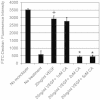The natural compound chebulagic acid inhibits vascular endothelial growth factor A mediated regulation of endothelial cell functions
- PMID: 25859636
- PMCID: PMC4819393
- DOI: 10.1038/srep09642
The natural compound chebulagic acid inhibits vascular endothelial growth factor A mediated regulation of endothelial cell functions
Abstract
Vascular endothelial growth factor A (VEGFA) plays an important role in tumour angiogenesis and its angiogenic action is mainly mediated through its VEGF receptor 2 (VEGFR-2). Therefore drugs targeting VEGFA/VEGFR-2 are being presently used in the clinics for treatment of several types of solid malignant tumours. We here in report that low dose of chebulagic acid (CA), a hydrolysable tannin found in myrobalan fruits can inhibit VEGFA induced vascular permeability, endothelial cell proliferation, migration, tube formation and thereby, angiogenesis by suppressing VEGFR-2 phosphorylation. CA may thus be an effective and useful natural inhibitor of VEGFA mediated angiogenesis.
Figures








Similar articles
-
Gold nanoparticles inhibit vascular endothelial growth factor-induced angiogenesis and vascular permeability via Src dependent pathway in retinal endothelial cells.Angiogenesis. 2011 Mar;14(1):29-45. doi: 10.1007/s10456-010-9193-x. Angiogenesis. 2011. Retraction in: Angiogenesis. 2011 Sep;14(3):409-10. doi: 10.1007/s10456-011-9225-1. PMID: 21061058 Retracted.
-
Decursin and decursinol angelate inhibit VEGF-induced angiogenesis via suppression of the VEGFR-2-signaling pathway.Carcinogenesis. 2009 Apr;30(4):655-61. doi: 10.1093/carcin/bgp039. Epub 2009 Feb 18. Carcinogenesis. 2009. PMID: 19228635
-
The tyrosine kinase inhibitor cediranib blocks ligand-induced vascular endothelial growth factor receptor-3 activity and lymphangiogenesis.Cancer Res. 2008 Jun 15;68(12):4754-62. doi: 10.1158/0008-5472.CAN-07-5809. Cancer Res. 2008. PMID: 18559522
-
Chebulagic acid Chebulinic acid and Gallic acid, the active principles of Triphala, inhibit TNFα induced pro-angiogenic and pro-inflammatory activities in retinal capillary endothelial cells by inhibiting p38, ERK and NFkB phosphorylation.Vascul Pharmacol. 2018 Sep;108:23-35. doi: 10.1016/j.vph.2018.04.005. Epub 2018 Apr 17. Vascul Pharmacol. 2018. PMID: 29678603
-
c-Jun N-terminal kinase mediated VEGFR2 sustained phosphorylation is critical for VEGFA-induced angiogenesis in vitro and in vivo.Cell Biochem Biophys. 2012 Sep;64(1):17-27. doi: 10.1007/s12013-012-9363-0. Cell Biochem Biophys. 2012. PMID: 22592917
Cited by
-
Vialinin A, an Edible Mushroom-Derived p-Terphenyl Antioxidant, Prevents VEGF-Induced Neovascularization In Vitro and In Vivo.Oxid Med Cell Longev. 2018 Feb 6;2018:1052102. doi: 10.1155/2018/1052102. eCollection 2018. Oxid Med Cell Longev. 2018. PMID: 29541344 Free PMC article.
-
Structure-Activity Relationship Studies on VEGFR2 Tyrosine Kinase Inhibitors for Identification of Potential Natural Anticancer Compounds.Med Chem. 2024;20(6):646-661. doi: 10.2174/0115734064247526231129080415. Med Chem. 2024. PMID: 38299297
-
Multiple Targets Directed Multiple Ligands: An In Silico and In Vitro Approach to Evaluating the Effect of Triphala on Angiogenesis.Biomolecules. 2020 Jan 23;10(2):177. doi: 10.3390/biom10020177. Biomolecules. 2020. PMID: 31979409 Free PMC article.
-
Activation of D2 Dopamine Receptors in CD133+ve Cancer Stem Cells in Non-small Cell Lung Carcinoma Inhibits Proliferation, Clonogenic Ability, and Invasiveness of These Cells.J Biol Chem. 2017 Jan 13;292(2):435-445. doi: 10.1074/jbc.M116.748970. Epub 2016 Dec 5. J Biol Chem. 2017. PMID: 27920206 Free PMC article.
-
Plants and their active compounds: natural molecules to target angiogenesis.Angiogenesis. 2016 Jul;19(3):287-95. doi: 10.1007/s10456-016-9512-y. Epub 2016 May 6. Angiogenesis. 2016. PMID: 27154020 Free PMC article. Review.
References
-
- Dvorak H. F. Vascular permeability factor/vascular endothelial growth factor: a critical cytokine in tumor angiogenesis and a potential target for diagnosis and therapy. J. Clin. Oncol. 20, 4368–4380 (2002). - PubMed
-
- Ferrara N. Vascular endothelial growth factor. Arterioscler. Thromb. Vasc. Biol. 29, 789–791 (2009). - PubMed
-
- Sloan B. & Scheinfeld N. S. Pazopanib, a VEGF receptor tyrosine kinase inhibitor for cancer therapy. Curr. Opin. Investig. Drugs. 9, 1324–1335 (2008). - PubMed
-
- Niraula S., Amir E., Vera-Badillo F., Seruga B., Ocana A. & Tannock I. F. Risk of incremental toxicities and associated costs of new anticancer drugs: a meta-analysis. J. Clin. Oncol. 32, 3634–3642 (2014). - PubMed
Publication types
MeSH terms
Substances
Grants and funding
LinkOut - more resources
Full Text Sources
Other Literature Sources

